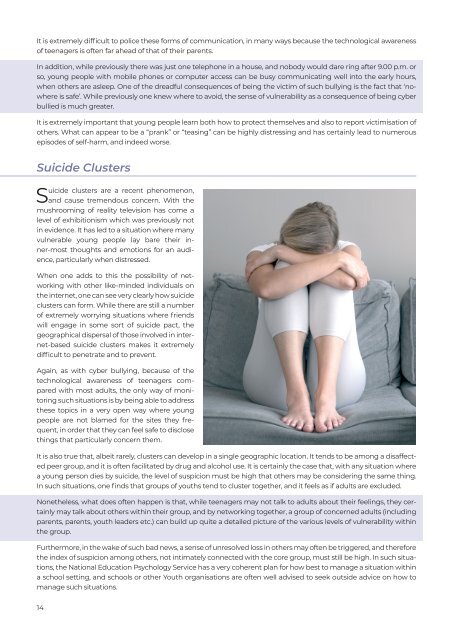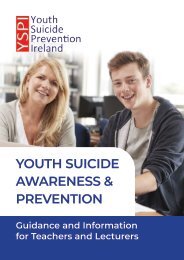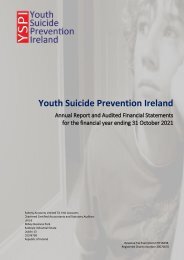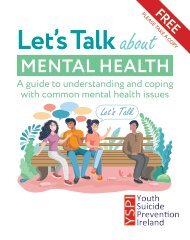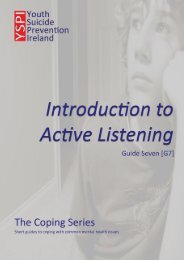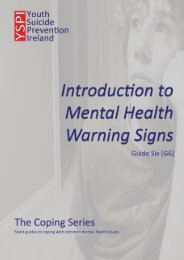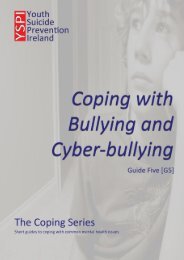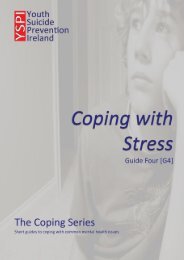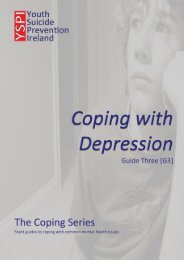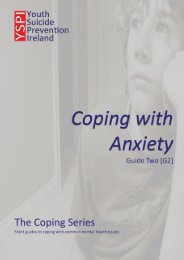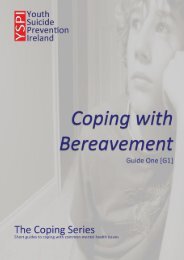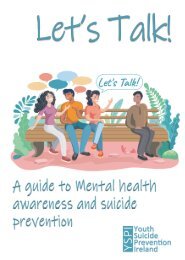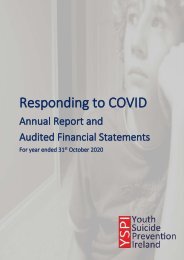What are they thinking? - YSPI Parents Handbook
A Parents Handbook to youth mental health and suicide prevention, now in it's 10th edition. Topics covered include: * Introduction to youth mental health awareness * Awareness of mental health risk factors * Recognising the symptoms of mental health issues * Helping someone with mental health issues * Understanding the dangers: Cyber-bullying Online Dangers Locked-away Syndrome * Supporting and developing coping strategies * Warnings signs of suicidal thoughts * Suicide Prevention and intervention * How to help and get help
A Parents Handbook to youth mental health and suicide prevention, now in it's 10th edition.
Topics covered include:
* Introduction to youth mental health awareness
* Awareness of mental health risk factors
* Recognising the symptoms of mental health issues
* Helping someone with mental health issues
* Understanding the dangers:
Cyber-bullying
Online Dangers
Locked-away Syndrome
* Supporting and developing coping strategies
* Warnings signs of suicidal thoughts
* Suicide Prevention and intervention
* How to help and get help
Create successful ePaper yourself
Turn your PDF publications into a flip-book with our unique Google optimized e-Paper software.
It is extremely difficult to police these forms of communication, in many ways because the technological aw<strong>are</strong>ness<br />
of teenagers is often far ahead of that of their p<strong>are</strong>nts.<br />
In addition, while previously there was just one telephone in a house, and nobody would d<strong>are</strong> ring after 9.00 p.m. or<br />
so, young people with mobile phones or computer access can be busy communicating well into the early hours,<br />
when others <strong>are</strong> asleep. One of the dreadful consequences of being the victim of such bullying is the fact that ‘nowhere<br />
is safe’. While previously one knew where to avoid, the sense of vulnerability as a consequence of being cyber<br />
bullied is much greater.<br />
It is extremely important that young people learn both how to protect themselves and also to report victimisation of<br />
others. <strong>What</strong> can appear to be a “prank” or “teasing” can be highly distressing and has certainly lead to numerous<br />
episodes of self-harm, and indeed worse.<br />
Suicide Clusters<br />
Suicide clusters <strong>are</strong> a recent phenomenon,<br />
and cause tremendous concern. With the<br />
mushrooming of reality television has come a<br />
level of exhibitionism which was previously not<br />
in evidence. It has led to a situation where many<br />
vulnerable young people lay b<strong>are</strong> their inner-most<br />
thoughts and emotions for an audience,<br />
particularly when distressed.<br />
When one adds to this the possibility of networking<br />
with other like-minded individuals on<br />
the internet, one can see very clearly how suicide<br />
clusters can form. While there <strong>are</strong> still a number<br />
of extremely worrying situations where friends<br />
will engage in some sort of suicide pact, the<br />
geographical dispersal of those involved in internet-based<br />
suicide clusters makes it extremely<br />
difficult to penetrate and to prevent.<br />
Again, as with cyber bullying, because of the<br />
technological aw<strong>are</strong>ness of teenagers comp<strong>are</strong>d<br />
with most adults, the only way of monitoring<br />
such situations is by being able to address<br />
these topics in a very open way where young<br />
people <strong>are</strong> not blamed for the sites <strong>they</strong> frequent,<br />
in order that <strong>they</strong> can feel safe to disclose<br />
things that particularly concern them.<br />
It is also true that, albeit r<strong>are</strong>ly, clusters can develop in a single geographic location. It tends to be among a disaffected<br />
peer group, and it is often facilitated by drug and alcohol use. It is certainly the case that, with any situation where<br />
a young person dies by suicide, the level of suspicion must be high that others may be considering the same thing.<br />
In such situations, one finds that groups of youths tend to cluster together, and it feels as if adults <strong>are</strong> excluded.<br />
Nonetheless, what does often happen is that, while teenagers may not talk to adults about their feelings, <strong>they</strong> certainly<br />
may talk about others within their group, and by networking together, a group of concerned adults (including<br />
p<strong>are</strong>nts, p<strong>are</strong>nts, youth leaders etc.) can build up quite a detailed picture of the various levels of vulnerability within<br />
the group.<br />
Furthermore, in the wake of such bad news, a sense of unresolved loss in others may often be triggered, and therefore<br />
the index of suspicion among others, not intimately connected with the core group, must still be high. In such situations,<br />
the National Education Psychology Service has a very coherent plan for how best to manage a situation within<br />
a school setting, and schools or other Youth organisations <strong>are</strong> often well advised to seek outside advice on how to<br />
manage such situations.<br />
14


